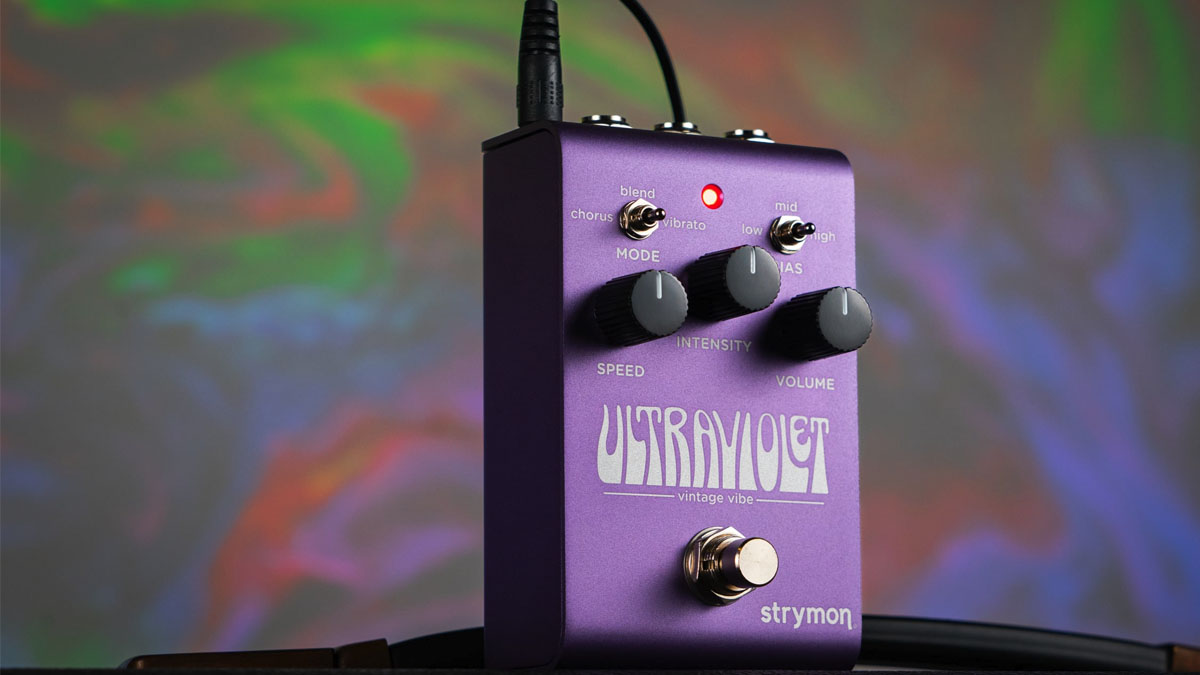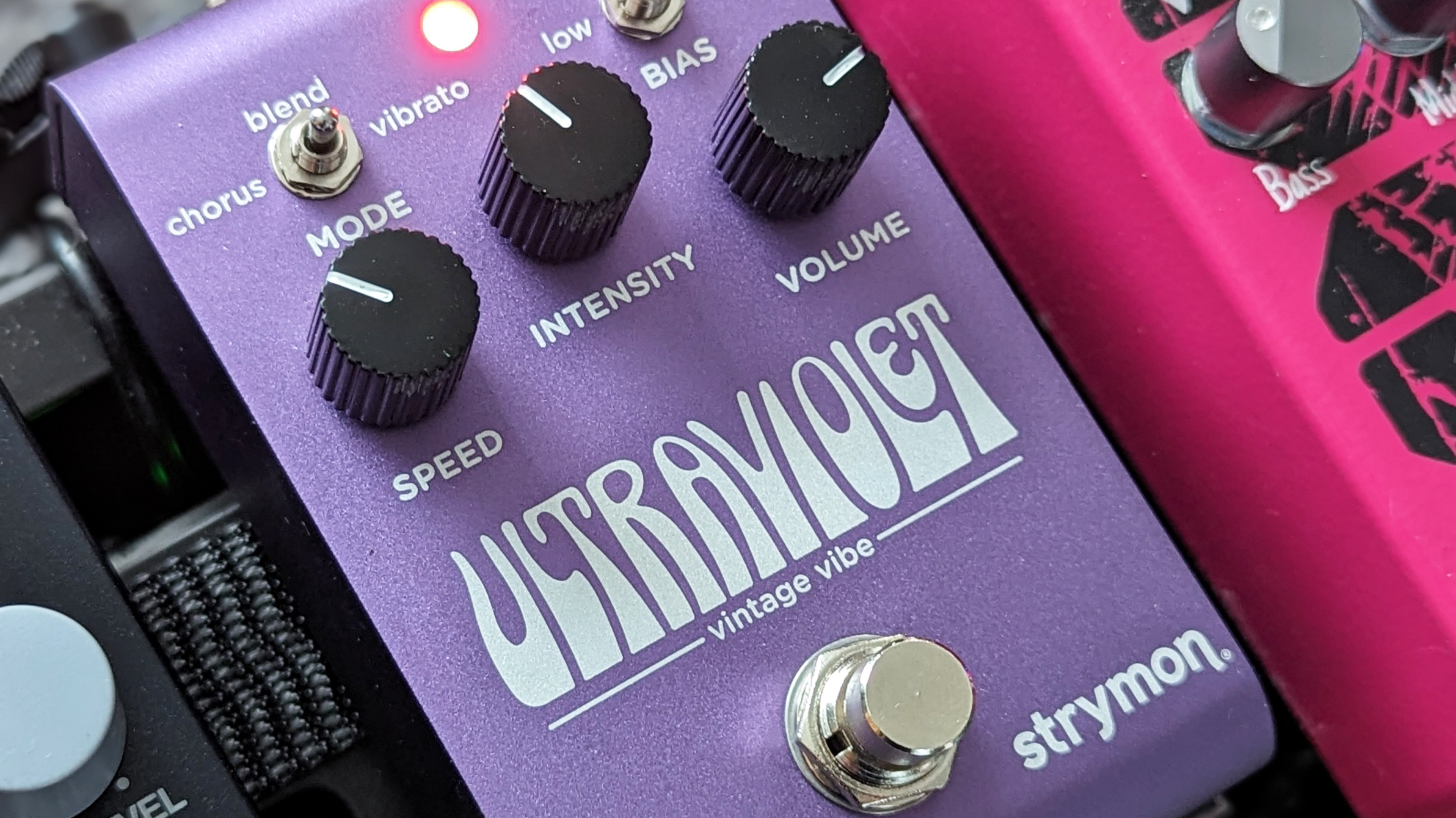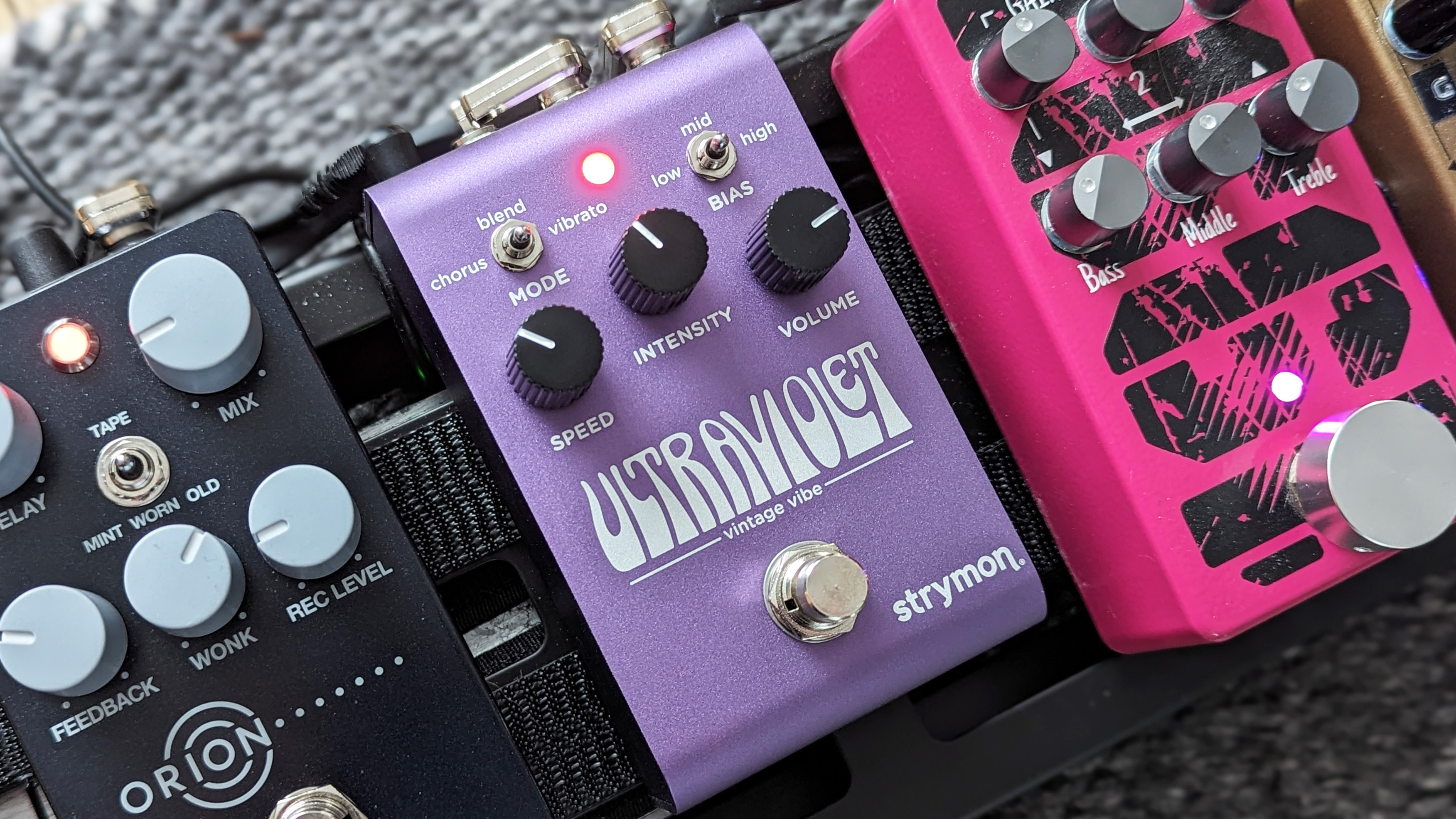MusicRadar Verdict
Another compact pedal from Strymon with deep versatility and lush sounds. The Blend mode here offers something new without alienating Univibe fans, but we just wish we could have a preset or tap tempo without spending more money.
Pros
- +
Wonderful univibe sounds that squeeze out more versatility
- +
Blend offers a really attractive mode
- +
Bias allows finer tuning, with responsive controls elsewhere
Cons
- -
A fairly heavy investment for a comparitavely niche effect
- -
A preset would be useful out of the box
- -
As would onboard tap tempo, without buying a Mini Switch
MusicRadar's got your back
Strymon UltraViolet Vintage Vibe Pedal: What is it?

The third release of 2023 in its new compact series, following the Cloudburst Ambient Reverb and Brig dBucket Delay, the UltraViolet is a very clear proposition: vintage Univibe sounds without the vintage inconsistencies and reliability issues. As ever with Strymon though, it wants to get as much out of its pedals' controls as possible to provide the pedal with plenty of scope, while offering a new twist on tradition.
In this respect it's no wonder the company has become a pros' choice time and time again; Strymon's marriage of vintage-style tones with the potentials of the digital realm sets a high bar. It's also hard to argue that of the three compact releases this year, the UltraViolet has the most select appeal. The Univibe conjures immediate sounds in my mind; the luxuriantly thick and inviting univibe chorus mode of Robin Trower on Bridge Of Sighs is one of the greatest guitar tones ever, but it's Trower's influence Jimi Hendrix who would blaze a glorious trail on the stage with it for iconic performances of Machine Gun, and the unforgettable Star-Spangled Banner.
It's a sound linked to the '60s and '70s of psychedelic-tinged blues-rock, and despite the patronage of heavier players including Mark Tremonti, it tends to attract players looking to draw on the psychedelic blues heritage. But in addition to nailing that, could the UltraViolet win more players around to adding some new vibes to their pedalboards?

As a brief recap before we go on, a univibe is a modulation effect – it takes your guitar signal in and out of phase at a speed and intensity that can be controlled. It's closest to a phaser, and you can hear that, but the original Shen Ei units distinguished themselves by using a lightbulb.
It was invented by Fumio Mieda – not the lightbulb, the univibe – in 1968, and a year later Hendrix had one onstage at Woodstock. I'm simplifying here but at the centre of the circuit board is a lightbulb with four sensors around it. The univibe's Low Frequency Oscillator (LFO) drivers activated by the bulb moving from bright to dim; the sensors detect it and activate the slow in and out of phase sound. The use of the bulb system imparts a delayed rise-and-fall character you can't quite get with a phaser/phase shifter.
Of course, this kind of operation also leads to inconsistency and unreliability. Viva le digital revolution, then. Now let's get back to it…
Strymon UltraViolet Vintage Vibe Pedal: Performance and verdict

The Speed, Intensity and Volume controls will be the most familiar first stops for many of us. Speed adjust the rate of the LFO sweep, Intensity adjusts the amplitude of that sweep, and Volume adjust output level – offering a 6db boost or cut at maximum that is useful for kicking in on crescendo parts and pushing your amp.
Want all the hottest music and gear news, reviews, deals, features and more, direct to your inbox? Sign up here.
Turn the intensity to zero and the UltraViolet gives a subtle phase EQ that's actually a very pleasant texture in itself. There's no oscillation at this point and the virtual bulb is resting. The pulse then offers a doubling effect on notes as Intensity is turned up – it really favours the dark punch of a Strat neck pickup to add a watery feel under your playing. The Speed, that you'll probably want to match to the tempo of whatever you're playing, emphasises the thickening effect further but the UltraViolet is able to offer extra intensity at the slower sweep speeds than a traditional univibe . This is akin to the brightness of your notes peaking in and out of the clouds formed by the slow sweeps and is really inspiring for brooding leads and adding movement to rhythm.
The pedal takes on more of a psychedelic wobbly tremolo character when the roles are reversed and Speed is pushed with Intensity dialled down. Further control is offered with the three-mode BIAS switch to set the center point of the LFO, and the effects are pronounced, especially when the Intensity is lower. While Mid is a balanced vibe sound that's probably the best place to begin for a while, the High and Low might initially confuse with their names and tonality. High is actually the darker sounding from the fixed EQ from the phase circuit because the higher frequencies are cancelled. At Low the higher frequencies are allowed to pass. So depending on your part's needs or your own general taste, you may want to venture out from Mid Bias accordingly.

The result is a milder mode that could be the one that really sells this pedal
I spend more time switching between Modes, and this is where the UltraViolet plays an ace card; while the traditional Vibrato's 100% wet signal and Chorus 50/50 are the traditional modes represented here, Strymon also offers a Blend of 70/30 for less dramatic frequency changes. The result is a milder mode that could be the one that really sells this pedal. It certainly does to me. It's unmistakably a univibe sound but it feels a little more adaptable to wider use. With the Speed off and Intensity at about 10 o'clock with High or Mid Bias I loved it for adding some movement to clean chords. Turning things up to midday on both for leads is my favorite unvibe sound for leads I've heard because it propels and fires up your playing without the more pronounced deep pulse of Chorus and pitchier retro pull of Vibrato. Some people may prefer that – and they're just a switch away.

But some things are not. Again, it's a digital pedal with no onboard preset as stock when the technology can surely allow it. Clearly, there's a price to be paid for Strymon's consistently excellent effects and the versatility each delivers in its chosen field, but for $259 we'd still expect it in 2023 without having to buy the $49 Mini Switch to access that and a tap tempo function. But in every other area, Strymon has done it again. Three modes, with huge scope to be explored in the parameters - with the option to take that usability even further with MIDI. Like the Brig's Multi mode, the third way of blend here adds an attractive USP here that could hook you in.
MusicRadar verdict: Another compact pedal from Strymon with deep versatility and lush sounds. The Blend mode of the UltraViolet offers something new without alienating Univibe fans, but we just wish we could have a preset or tap tempo without spending more money.
Strymon UltraViolet Vintage Vibe Pedal: Hands-on demos
Strymon
Antoine Michaud
Chords Of Orion
Mike Hermans
Strymon UltraViolet Vintage Vibe Pedal: Specifications

- TYPE: Digital univibe pedal with three modes
- ORIGIN: USA
- CONTROLS: Speed, Intensity, Volume, Mode three-way mini toggle, Bias three-way middle toggle, bypass footswitch (hold to enter MIDI save mode)
- FEATURES: TRS stereo input and output jacks, mono/stereo switch, USB-C for firmware updates, Expression / MIDI input jack
- BYPASS: True or buffered (use mono input for true and stereo input for buffered)
- POWER: 9V centre-negative power supply (250mA minimum draw, PSU not included)
- CONTACT: Strymon

Rob is the Reviews Editor for GuitarWorld.com and MusicRadar guitars, so spends most of his waking hours (and beyond) thinking about and trying the latest gear while making sure our reviews team is giving you thorough and honest tests of it. He's worked for guitar mags and sites as a writer and editor for nearly 20 years but still winces at the thought of restringing anything with a Floyd Rose.
